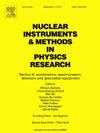CMS RPC L1在CMSSW触发集群
IF 1.5
3区 物理与天体物理
Q3 INSTRUMENTS & INSTRUMENTATION
Nuclear Instruments & Methods in Physics Research Section A-accelerators Spectrometers Detectors and Associated Equipment
Pub Date : 2025-03-20
DOI:10.1016/j.nima.2025.170363
引用次数: 0
摘要
大型强子对撞机上的紧凑型介子螺线管探测器是一种多用途实验,用于研究质子-质子和重离子碰撞。它具有3.8 T螺线管磁铁,硅跟踪器,电磁和强子量热计和μ子系统。对于高亮度大型强子对撞机,CMS将进行第二阶段的升级,以处理更高的碰撞率,每束交叉的相互作用从50增加到140/200,碰撞能量达到14 TeV,峰值亮度上升到5 - 7.5×1034 cm−2s−1。这些升级旨在实现更精确的标准模型测量,改进希格斯部门,并寻找超越标准模型的物理。本文介绍了Endcap μ on Track Finder ++算法的主要特点,该算法是在CMS软件中开发的;它是为目前使用的Endcap寻迹器的第二阶段开发的一级触发算法升级。使用预训练模型,在有和没有RPC和iRPC ((i)RPC)信息的模拟上计算算法的效率。本文章由计算机程序翻译,如有差异,请以英文原文为准。
CMS RPC L1 Trigger clustering at CMSSW
The Compact Muon Solenoid detector at the Large Hadron Collider is a multipurpose experiment designed for studying proton–proton and heavy-ion collisions. It features a 3.8 T Solenoid magnet, a Silicon tracker, Electromagnetic and Hadronic Calorimeters, and the Muon system. For the High Luminosity LHC, CMS will undergo Phase-2 upgrades to handle higher collision rates, with PileUp increasing from 50 to 140/200 interactions per bunch crossing, collision energy reaching 14 TeV, and peak luminosity rising to . These upgrades aim to enable even more precise Standard Model measurements, improvements in the Higgs sector, and searches for Beyond Standard Model physics. This document describes the main features of the Endcap Muon Track Finder ++ algorithm, developed in the CMS Software; it is the Level 1 Trigger algorithm upgrade being developed for Phase-2 of the currently used Endcap Track Finder. The efficiency of the algorithm was computed on simulations generated with and without RPC and iRPC ((i)RPC) information, using a pre-trained model.
求助全文
通过发布文献求助,成功后即可免费获取论文全文。
去求助
来源期刊
CiteScore
3.20
自引率
21.40%
发文量
787
审稿时长
1 months
期刊介绍:
Section A of Nuclear Instruments and Methods in Physics Research publishes papers on design, manufacturing and performance of scientific instruments with an emphasis on large scale facilities. This includes the development of particle accelerators, ion sources, beam transport systems and target arrangements as well as the use of secondary phenomena such as synchrotron radiation and free electron lasers. It also includes all types of instrumentation for the detection and spectrometry of radiations from high energy processes and nuclear decays, as well as instrumentation for experiments at nuclear reactors. Specialized electronics for nuclear and other types of spectrometry as well as computerization of measurements and control systems in this area also find their place in the A section.
Theoretical as well as experimental papers are accepted.

 求助内容:
求助内容: 应助结果提醒方式:
应助结果提醒方式:


